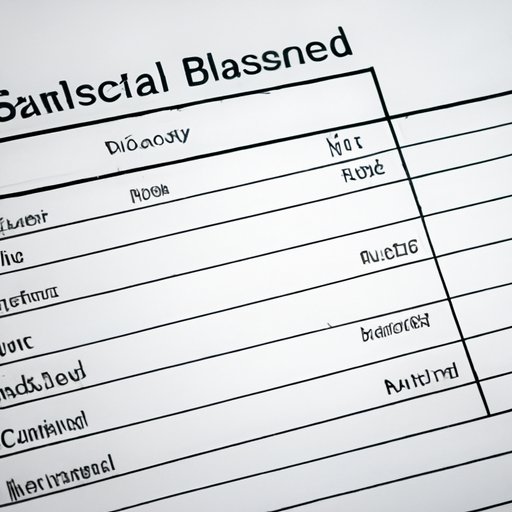I. Introduction
When it comes to investing in stocks or other financial instruments, understanding a company’s financial health is crucial. One tool that investors can use to assess a company’s financial situation is the balance sheet. This document summarizes a company’s assets, liabilities, and equity, providing a snapshot of its financial position at a given point in time.
One important type of balance sheet is the classified balance sheet, which breaks down assets into subsections based on liquidity. This article will explore how understanding asset subsections on a classified balance sheet can help investors make more informed decisions.

II. Demystifying the Classified Balance Sheet: How to Better Understand Asset Subsections
A classified balance sheet is a type of financial statement that organizes a company’s assets and liabilities into subcategories. These subcategories allow investors to better understand the liquidity and risk associated with each asset and liability.
The primary difference between a classified and an unclassified balance sheet is that the latter organizes assets and liabilities into broad categories without any additional subcategories.
The purpose of asset subsections on a classified balance sheet is to provide investors with a clearer picture of a company’s financial health. By breaking down assets into categories based on their liquidity, investors can better determine how easily a company can access cash to cover its current obligations.
III. A Closer Look: Breaking Down the Asset Subsections on a Classified Balance Sheet
A typical classified balance sheet will contain the following asset subsections:
Current assets
Current assets are those that are expected to be converted into cash within one year. Examples of current assets include cash and cash equivalents, accounts receivable, inventory, and short-term investments. Understanding a company’s current assets is crucial for monitoring its ability to pay off its short-term debts and expenses.
Long-term investments
Long-term investments are those that a company plans to hold for more than one year. These may include stocks, bonds, and real estate. Long-term investments are typically less liquid than current assets and are not expected to be converted into cash in the short term.
Property, plant, and equipment
Property, plant, and equipment, or PP&E, are the physical assets that a company owns and uses to conduct its operations. This may include land, buildings, machinery, and automobiles. PP&E assets are usually held for several years and depreciate over time.
Intangible assets
Intangible assets are those that are not physical in nature but have value to the company, such as patents, trademarks, and copyrights. These assets are typically difficult to value and may not generate cash flows immediately.
Other assets
Other assets are those that do not fit into any of the above categories. This may include non-current receivables, deferred tax assets, and prepaid expenses.
By understanding what each asset subsection represents, investors can gain a better understanding of a company’s financial position and liquidity.
IV. Why a Classified Balance Sheet is Vital: Unlocking Asset Subsections for Investors
Analyzing a classified balance sheet can help investors make more informed decisions and assess a company’s financial health. For example, if a company’s current assets are predominantly made up of inventory rather than cash and cash equivalents, this may indicate that the company is having trouble converting its inventory into cash. This could signal a potential red flag for investors.
Additionally, understanding the level of debt a company has, compared to its assets, can help investors determine its overall financial health. This is known as the debt-to-asset ratio, which can provide insight into how risky a company’s debt is.
Real-life examples of how understanding asset subsections can impact investment decisions include the 2008 financial crisis, where many investors were caught off guard by the high levels of risky assets held by major financial institutions. By analyzing the asset subsections of their balance sheets, these risks could have been identified earlier.
V. Mastering Asset Subsections: A Guide to Interpreting the Classified Balance Sheet
To get the most out of a classified balance sheet, investors should employ a few practical tips for interpreting the information presented in each asset subsection.
For example, investors should compare a company’s current assets to its current liabilities to determine its ability to cover its short-term obligations. Similarly, investors should evaluate a company’s PP&E assets to understand its operational efficiency and potential for growth.
By following a step-by-step guide to evaluating a company’s financial health using a classified balance sheet, investors can make more informed investment decisions and identify potential risks or areas of concern.
VI. The Significance of Asset Subsections: Decoding the Classified Balance Sheet
Understanding asset subsections on a classified balance sheet is crucial for making informed investment decisions. By analyzing each subsection, investors can identify potential red flags or areas of concern, as well as compare a company’s performance across different industries.
Other benefits of understanding asset subsections include:
– Identifying potential areas for growth within a company
– Determining a company’s overall financial stability
– Evaluating management’s effectiveness in deploying company resources.
VII. Maximizing Your Financial Analysis: Exploring the Asset Subsections on a Classified Balance Sheet
In conclusion, classified balance sheets provide an in-depth look at a company’s financial situation, particularly its liquidity and level of debt. By understanding each asset subsection, investors can make more informed decision-making when it comes to investments.
Remember to always compare a company’s financial position to its competitors within the industry and be aware of risks. By following the tips and guidelines outlined in this article, investors can conduct their own financial analysis using the information provided and make smarter investment decisions.
VIII. Conclusion
In summary, a classified balance sheet can provide valuable insights into a company’s financial position. By understanding the significance of asset subsections on a classified balance sheet, investors can make more informed investment decisions and identify potential opportunities or risks. By following the tips and guidelines outlined above, investors can conduct their own financial analysis using a classified balance sheet, and ultimately, improve their investment strategies.
